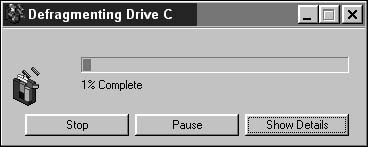Linux and Windows on the Same System
Many people want to run Linux and Windows on the same system. Why? Well, you might want to do this if you have only one computer and are not ready to give up running your Windows applications until you have tried those available under Linux. Or you might just want to be able to run both Linux and Windows on the same machine.
It is perfectly reasonable to want to do this. However, you should understand before you start that this "double OS" kind of installation involves many variables, some degree of difficulty, and some danger to all the data on your system.
Note
This "double OS" kind of installation involves many variables, some degree of difficulty, and some danger to all the data on your system.
Before you start, it is essential to back up any data you care about.
You should also have a clear conceptual understanding of the process before you start the repartitioning process. That process is outlined next.
Note
the following roadmap is provided as a conceptual overview. The steps for completing it are described in detail later in this chapter.
To install Linux and keep Windows:
1. | Make sure you have enough space on your hard drive for Linux as well as your current Windows files. If you have less than 750MB free, you probably will not be able to perform an optimal Red Hat Linux 6 installation. |
2. | Defragment your Windows hard drive to move all the data on it to the beginning of the drive so that there will be space for Linux partitions. |
3. | Before leaving Windows, jot down your hardware settings (a page is provided in the back of this book, just after the index, for you to jot down this information). |
4. | Repartition your Windows hard drive to add Linux partitions. |
5. | Complete the installation program to install Linux on the appropriate partitions. |
6. | Copy the LILO bootstrap loader to one of the partitions on your hard drive. If, for some reason, LILO will not work to multi-boot with your system, then you will need to organize another way to start Linux: for example, from a boot floppy. |
Tip
If you have an extra machine, strongly consider giving Linux a "room of its own" by installing it by itself on that machine.
Tip
It's easier to install Linux on a system with Windows if each operating system has its own physical hard drive.
Tip
You may have only have one physical hard drive but more than one logical hard drive under Windows. If so, you may want to consider reformatting one of the logical Windows drives as a Linux drive, rather than carving a partition out of a logical Windows drive for Linux.
Tip
Using a boot floppy means that a Linux floppy disk is placed in your A drive when you want to start the computer in Linux. When you want to start it in Windows, the disk is left out of the drive. This is actually a sane way to do things, and quite bullet-proof (more on this later).
To defragment a Windows drive:
1. | Right-click the My Computer icon on your Windows desktop and select Explore from the pop-up menu. Windows Explorer will open (Figure 2.1) Figure 2.1. To defragment a drive—which moves all the data on the drive to the beginning of the drive—first select it in Windows Exploer.
|
2. | Find and select the drive you want to defragment. |
3. | Right-click the drive and select Properties from the pop-up menu. The drive's Properties dialog box will open. |
4. | Choose the Tools tab of the Properties dialog box (Figure 2.2). Figure 2.2. Choose Defragment Now from the Tools tab of the drive's Properties dialog box to open the defragmentation utility.
|
5. | Click Defragment Now. A dialog box containing a slider bar that shows defragmentation progress will open (Figure 2.3). |
Tip
If you'd like to see a real-time graphic representation of the disk data that the defragmentation utility is moving, click Show Details.
Tip
The defragmentation utility may uncover errors on your hard drive that must be fixed before it can proceed (see the next section).
Figure 2.3. Choose Show Details to view a display of disk data being moved.

To fix errors on a hard drive:
1. | With Windows Explorer open, select the drive you want to defragment. |
2. | Right-click the drive and select Properties from the pop up menu. The drive's Properties dialog box will open. |
3. | Choose the Tools tab of the Properties dialog box. |
4. | In the Error-Checking Status frame, choose Check Now. The ScanDisk dialog box will open (Figure 2.4). Figure 2.4. Run ScanDisk to fix any errors on your drive that the defragmentation utility finds.
|
5. | Check the Automatically Fix Errors box. |
6. | Click Start. |
Warning
As mentioned elsewhere, the version of Linux on the CD in this book is not supported by Red Hat or Peachpit Press. We've made every effort to make these instructions as accurate and complete as possible, but there are simply too many installation possibilities and configurations to fully cover them here. See the documentation on the Red Hat Web site (http://www.redhat.com) and on the CD-ROM itself. You may purchase techical support for the software by calling 1-888-REDHAT1.



